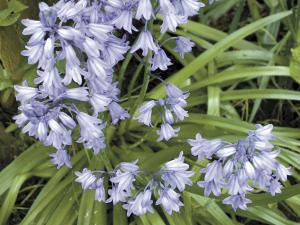Cuban lily nice enough to grow as foliage plant
Winter is a fact of life, and there’s no reason to limit your gardening to the outdoors. Studies show that any living plants in the house have a calming, restorative effect on us. The oxygen they create is just a nice bonus. Like all things in the garden it just seems more fun to grow something exotic. When huge, plump game birds arrived in England from Turkey, the birds were forever known as “turkeys” even though they are native to North America.
A small, easy-to-grow flowering houseplant has a similar confusion. Native to Spain, a shipment of bulbs arrived in England aboard the ship named Peru and were given the scientific name “peruviana” by Carolus Linnaeus in 1753. This Spanish scilla was widely grown in Cuba and now goes by the nickname Cuban Lily. Rules are rules, and once a plant is named, the name cannot be changed, so the houseplant from Spain known as the Cuban Lily is scientifically the Peruvian Scilla peruviana.
The green, strappy leaves are nice enough to grow just as a foliage plant. The leaves can get up to a foot long, but usually are sold when just eight inches or so. The flower is a long-lasting. six-inch-high globe of individual tiny flowers, often hundreds packed in each flower ball. The tiny florets on the top of the stem are packed in so tightly that it looks like the flower ball is wearing a hat.
The Cuban lily does best in soil that is not too rich, but drains easily. Because it is not frost hardy, it is best as a potted plant. It is hardy outdoors in USDA zones 7 through 10.
Use a large pot so that you can leave the bulb undisturbed for several years. Many growers feel that this plant does best when slightly overcrowded or pot-bound. You can move the pot outdoors for the summer, after all threat of frost has passed.
Feed your Cuban lily regularly while it is growing. Choose a good organic liquid fertilizer meant for blooming plants. It will contain more phosphorus and less nitrogen than other fertilizers.
Every summer, Cuban lily plants go into a short dormancy for about two months. In their native lands, this period is usually one of absolutely no water and hot temperatures.
Avoid overwatering, especially during the hot summer months.
After a few years your Cuban lily may form a clump of several bulbs. You can divide this clump and repot the bulbs immediately. You can also grow bulbs from seeds quite easily. Collect the tiny seeds after the flowers fade and plant them by early fall.
So bring home a potted Cuban lily, and while you are sitting in a cozy chair on a dreary winter day, think of the journey this small bulb has made from native Spain to England to Cuba and now to your windowsill. Thanks to a ship called Peru.





















































